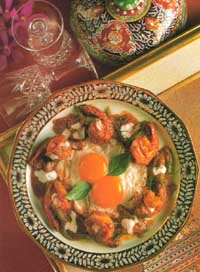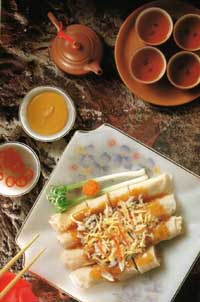The first step when giving a banquet is to go to the
selected restaurant and discuss the number of tables (each normally
seating ten guests), the intended expenditure per table (of vital
importance) and the menu. As gourmets of the world acknowledge, Chinese
food vies with that of France for world supremacy. The almost infinite
variety of dishes could conceivably make finalizing a menu an
insurmountable problem. However, there are well-defined traditions and the
task is not as difficult as it might seem.
Chinese food is generally classified into three broad
categories: home cooking, restaurant cooking and banquet cooking. The
former includes moderately priced, relatively simple everyday dishes that
do not require sophisticated cooking utensils and techniques. Restaurant
cooking requires more complex methods and expensive ingredients. The
banquets are the occasion for the most exquisite, most expensive and most
delectable dishes within the scope of the Chinese cook. The presentation
of banquet food is also highly important, and dishes are selected for
their eye appeal as well as their taste.
 Salty
“son-in-law’s-eggs” are just one dish in an infinite variety of
choices.
Salty
“son-in-law’s-eggs” are just one dish in an infinite variety of
choices.
Before delving into the mysteries of menu selection,
it’s important to understand the basic attitude towards food. According
to Taoist principles, the universe is divided into two opposing yet
complimentary forces: ‘yin’ and ‘yang’. The constant working of
these forces provides a state of equilibrium. Dynamic balance achieved
through the working of contrasts is an essential part of the Chinese
approach to food. As one expert described it, “The art of Chinese
cooking lies in the selection, blending and harmonizing of texture, color,
aroma and taste. The Chinese feast is a study in contrast. Sweets are
played against salts, smoothness against crunchiness, large foods against
miniature ones and hot foods against cold ones.”
Bearing in mind the contrasts essential within
individual dishes and between courses, the host and the restaurateur may
possibly come up with the following menu for a “no expenses spared”
banquet. A cold dish or hors d’oeuvre consisting of Yunan ham, steamed
large prawns, kidney flower, pigs’ throat, black mushrooms, jellyfish
and vegetarian chicken. It is often said that the quality of the
restaurant or chef can be judged by the cold dish, so an establishment
that prides itself on its standard will make sure this first course
titillates the palate for what is to follow.
Braised whole sharks’ fin, a delicacy that involves
soaking and cooking cured sharks fin, will form the second course.
Shredded sharks’ fin, while tasty and of a wonderfully gelatinous
texture, is only about one-third the price of a whole fin, therefore it is
preferred for lavish occasions. A whole carp steamed or braised with fresh
ginger to remove any ‘fishy’ smell and delicately seasoned with
Chinese rice wine and other ingredients will be the third course.
 Preparation
and eye appeal is vital in Chinese cuisine.
Preparation
and eye appeal is vital in Chinese cuisine.
Next comes suckling pig, a four kilo piglet roasted
until the skin is delicately crisp. Since there will be little meat on
this small creature, the emphasis in this dish is on the texture and
flavor of the skin, which is dipped into a thick black sauce before eaten.
By now the banquet is into its fifth course, the
honey-baked Yunan Ham. This boned ham comes from western China and is
basted with a honey sauce throughout cooking and is eaten wrapped inside
small steamed buns. Vegetables are an important part of any Chinese meal,
and will come next. A combination of bamboo heart, black fungus, dried
black mushrooms, fresh champignons and dried seaweed known as ‘fat chye’
are sometimes referred to as Vegetables Deluxe.
In banquets, where soup is made from rare ingredients,
it is served as a separate course to give it the attention it deserves. As
it is the seventh course, a truly lavish banquet will often feature
bird’s nest soup. A highly prized delicacy, dried swallow spittle is
extracted from nests gathered in Southeast Asia. Considered highly
nutritious, it has almost no taste and is flavored with chicken stock and
a little ham. Peking duck will follow the soup. This is served with thin
wheat flour pancakes, thick black plum sauce and pieces of spring onion.
The crisp skin is as delicious as the well flavored meat.
Peking noodles may come next if the food is northern
Chinese. If southern cuisine is served, the noodles will be replaced with
fried rice. Considered bad manners to eat more than a mouthful or two of
this course because it implies that you have not had sufficient food up
until now, few people will eat much more by this stage.
The banquet will be brought to its conclusion by a
dessert. Triple-none-stuck, a curiously named dish that is basically sweet
scrambled eggs is a northern favorite, while southern Chinese prefer
almond jelly with lynches. On special occasions other appropriate dishes
will be included. Cantonese wedding banquets include red roasted pig,
which an engagement part is an occasion for a steamed cake in the shape of
two hearts. Sometimes a special rice wine will also be served.

 Salty
“son-in-law’s-eggs” are just one dish in an infinite variety of
choices.
Salty
“son-in-law’s-eggs” are just one dish in an infinite variety of
choices. Preparation
and eye appeal is vital in Chinese cuisine.
Preparation
and eye appeal is vital in Chinese cuisine.
